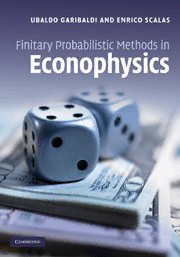Table Of ContentThis page intentionally left blank
FINITARY PROBABILISTIC METHODS IN
ECONOPHYSICS
Econophysics applies the methodology of physics to the study of economics.
However, whilst physicists have a good understanding of statistical physics, they
areoftenunfamiliarwithrecentadvancesinstatistics,includingBayesianandpre-
dictivemethods.Equally,economistswithknowledgeofprobabilitiesdonothave
a background in statistical physics and agent-based models. Proposing a unified
viewforadynamicprobabilisticapproach,thisbookisusefulforadvancedunder-
graduate and graduate students as well as researchers in physics, economics and
finance.
The book takes a finitary approach to the subject. It discusses the essentials of
applied probability, and covers finite Markov chain theory and its applications to
real systems. Each chapter ends with a summary, suggestions for further reading
andexerciseswithsolutionsattheendofthebook.
Ubaldo Garibaldi is First Researcher at the IMEM-CNR, Italy, where he
researches the foundations of probability, statistics and statistical mechanics, and
theapplicationoffiniteMarkovchainstocomplexsystems.
Enrico Scalas isAssistant Professor of Physics at the University of Eastern
Piedmont, Italy. His research interests are anomalous diffusion and its applica-
tionstocomplexsystems,thefoundationsofstatisticalmechanicsandagent-based
simulationsinphysics,financeandeconomics.
FINITARY PROBABILISTIC
METHODS IN ECONOPHYSICS
UBALDO GARIBALDI
IMEM-CNR,Italy
ENRICO SCALAS
UniversityofEasternPiedmont,Italy
CAMBRIDGE UNIVERSITY PRESS
Cambridge, New York, Melbourne, Madrid, Cape Town, Singapore,
São Paulo, Delhi, Dubai, Tokyo
Cambridge University Press
The Edinburgh Building, Cambridge CB2 8RU, UK
Published in the United States of America by Cambridge University Press, New York
www.cambridge.org
Information on this title: www.cambridge.org/9780521515597
© U. Garibaldi and E. Scalas 2010
This publication is in copyright. Subject to statutory exception and to the
provision of relevant collective licensing agreements, no reproduction of any part
may take place without the written permission of Cambridge University Press.
First published in print format 2010
ISBN-13 978-0-511-90205-5 eBook (NetLibrary)
ISBN-13 978-0-521-51559-7 Hardback
Cambridge University Press has no responsibility for the persistence or accuracy
of urls for external or third-party internet websites referred to in this publication,
and does not guarantee that any content on such websites is, or will remain,
accurate or appropriate.
Contents
Foreword page ix
Acknowledgements xiii
1 Introductoryremarks 1
1.1 Earlyaccountsandthebirthofmathematicalprobability 1
1.2 Laplaceandtheclassicaldefinitionofprobability 3
1.3 Frequentism 8
1.4 Subjectivism,neo-Bayesianismandlogicism 10
1.5 Fromdefinitionstointerpretations 12
Furtherreading 13
References 13
2 Individualandstatisticaldescriptions 15
2.1 Jointα-descriptionsands-descriptions 15
2.2 Frequencyvectorandindividualdescriptions 18
2.3 Partitions 19
2.4 Partialandmarginaldescriptions 20
2.5 Exercises 24
2.6 Summary 24
Furtherreading 25
3 Probabilityandevents 26
3.1 Elementarydescriptionsandevents 26
3.2 Decompositionsofthesamplespace 29
3.3 Remarksondistributions 32
3.4 Probabilityassignments 35
3.5 Remarksonurnmodelsandpredictiveprobabilities 39
3.6 Appendix:outlineofelementaryprobabilitytheory 42
3.7 Exercises 54
3.8 Summary 55
Furtherreading 55
References 57
v
vi Contents
4 Finiterandomvariablesandstochasticprocesses 58
4.1 Finiterandomvariables 58
4.2 Finitestochasticprocesses 73
4.3 Appendix1:afiniteversionofdeFinetti’stheorem 86
4.4 Appendix2:thebetadistribution 92
4.5 Exercises 93
4.6 Summary 93
Furtherreading 94
References 95
5 ThePólyaprocess 96
5.1 DefinitionofthePólyaprocess 96
5.2 ThefirstmomentsofthePólyadistribution 100
5.3 Labelmixingandmarginaldistributions 104
(cid:1)
5.4 Aconsequenceoftheconstraint n =n 116
i
5.5 ThecontinuumlimitsofthemultivariatePólyadistribution 116
5.6 Thefundamentalrepresentationtheoremforthe
Pólyaprocess 123
5.7 Exercises 130
5.8 Summary 131
Furtherreading 132
6 TimeevolutionandfiniteMarkovchains 134
6.1 FromkinematicstoMarkovianprobabilisticdynamics 134
6.2 TheEhrenfesturnmodel 139
6.3 FiniteMarkovchains 141
6.4 Convergencetoalimitingdistribution 146
6.5 Theinvariantdistribution 152
6.6 Reversibility 160
6.7 Exercises 166
6.8 Summary 169
Furtherreading 169
References 171
7 TheEhrenfest–Brillouinmodel 172
7.1 MergingEhrenfest-likedestructionsand
Brillouin-likecreations 172
7.2 Unarymoves 174
7.3 Fromfleastoants 177
7.4 Morecomplicatedmoves 180
7.5 Pólyadistributionstructures 181
7.6 Anapplicationtostockpricedynamics 188
7.7 Exogenousconstraintsandthemostprobable
occupationvector 193
Contents vii
7.8 Exercises 201
7.9 Summary 201
Furtherreading 202
8 Applicationstostylizedmodelsineconomics 204
8.1 Amodelforrandomcoinexchange 204
8.2 Thetaxation–redistributionmodel 212
8.3 TheAoki–Yoshikawamodelforsectoralproductivity 217
8.4 Generalremarksonstatisticalequilibriumineconomics 223
8.5 Exercises 225
8.6 Summary 225
Furtherreading 226
References 228
9 FinitarycharacterizationoftheEwenssamplingformula 229
9.1 Infinitenumberofcategories 229
9.2 FinitaryderivationoftheEwenssamplingformula 232
9.3 Clusternumberdistribution 238
9.4 Ewens’momentsandsite-labelmarginals 240
9.5 Alternativederivationoftheexpectednumberofclusters 243
9.6 Samplingandaccommodation 244
9.7 Markovchainsforclusterandsitedynamics 247
9.8 Marginalclusterdynamicsandsitedynamics 250
9.9 Thetwo-parameterEwensprocess 256
9.10 Summary 259
Furtherreading 260
10 TheZipf–Simon–Yuleprocess 262
10.1 TheEwenssamplingformulaandfirmsizes 262
10.2 Hoppe’svs.Zipf’surn 263
10.3 ExpectedclustersizedynamicsandtheYuledistribution 265
10.4 BirthanddeathSimon–Zipf’sprocess 269
10.5 MarginaldescriptionoftheSimon–Zipfprocess 271
10.6 Aformalreversiblebirth-and-deathmarginalchain 274
10.7 MonteCarlosimulations 276
10.8 Continuouslimitanddiffusions 279
10.9 Appendix1:invariantmeasureforhomogeneousdiffusions 286
10.10 Summary 287
Furtherreading 288
Appendix 289
Solutionstoexercises 289
Authorindex 323
Subjectindex 325

